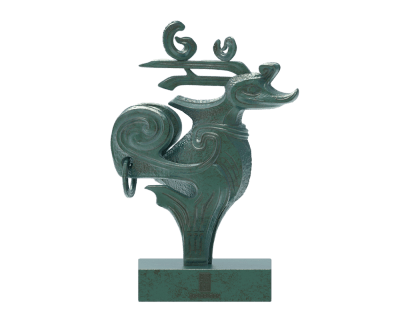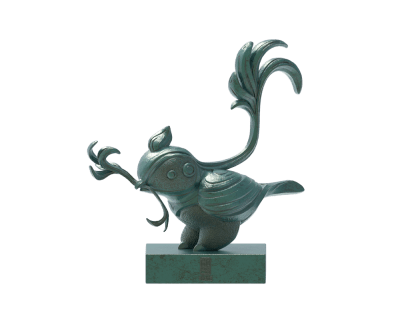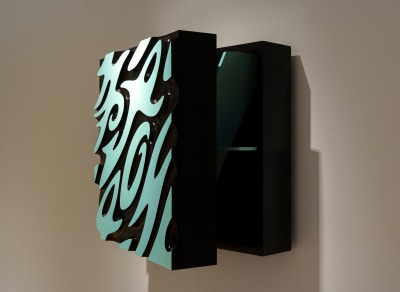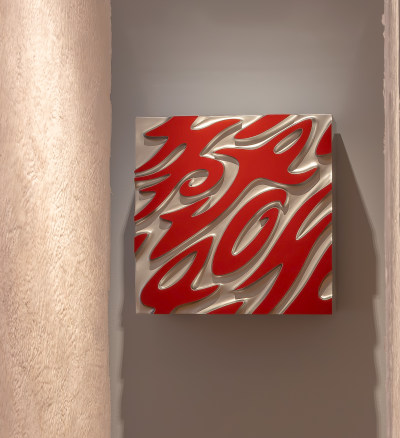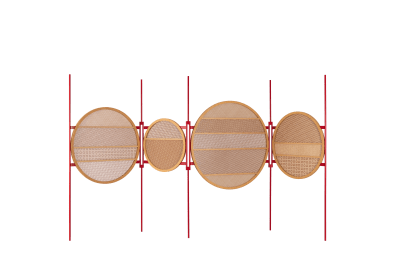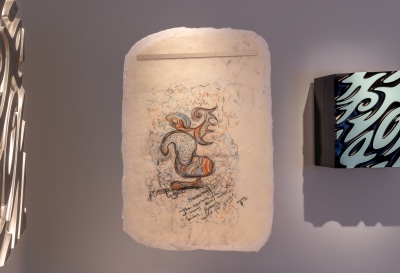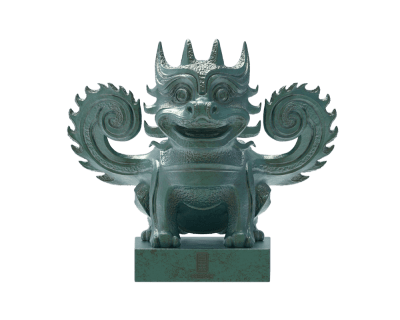Biography
Waddington Custot is pleased to present 'Guardians of Time', the first UK exhibition by acclaimed Chinese artist and designer, Jiang Qiong Er. Known internationally for bridging traditional Chinese craftsmanship with contemporary design, Qiong Er presents a series of sculptural installations, wax paintings and design objects that reimagine ancient Chinese mythology and cultural symbols through 21st century motifs. Through this, the artist offers a meditation on time, renewal and cultural memory. Her works draw on centuries-old narratives while asking urgent questions about cultural preservation and transformation.
At the centre of the exhibition is ‘XII Calls’, a bronze installation inspired by mythical creatures from ancient civilisations Each figure embodies a universal value: Bravery, Wisdom, Equality, Nature, Fraternity, Exploration, Time, Inclusion, Benevolence, Authenticity, Peace and Freedom. These hybrid, syncretic beings form a contemporary bestiary addressing urgent questions about cultural preservation in a rapidly evolving world.
First unveiled on the façade of the Guimet Museum in Paris in 2024, one set of ‘XII Calls’ has since been acquired for UNESCO’s permanent collection, displayed at the organisation’s Paris headquarters alongside Alberto Giacometti’s ‘Walking Man’, testament to the enduring, universal values represented by Qiong Er’s designs. The acquisition reflects Qiong Er’s inclusion in other prestigious permanent collections worldwide, such as the Victoria and Albert Museum and the British Museum. As Qiong Er explains:
“Art is a gentle form of cultural dialogue. It transcends borders and ideologies, reconnecting people through emotion and symbolism… It can be heard by the world without having to be translated.”
In ‘XII Calls – Wax Paintings’, a series debuting in London, Qiong Er extends her exploration of time and transformation into wax for the first time. Each work begins as a charcoal drawing, transferred to a silicone plate and overlaid with molten wax at around 80 °C, repeated dozens or even hundreds of times. Through this accretive process, the image is absorbed, inverted and embedded within the wax; this white expanse becomes the artist’s ‘paper.’ For Qiong Er, wax is both medium and metaphor: a substance capable of solidifying and melting, moving backward and forward, holding time in suspension. In these works, memories and emotions are not fixed to a surface but preserved within a luminous, tactile depth, where image and temporality converge.
Another highlight is ‘Her Voice’, a powerful installation dedicated to Nüshu, an endangered women’s script of Hunan province. Translating literally as ‘women’s script’, Nüshu was the only writing system in the world created and used exclusively by women, offering them a secret mode of communication in a patriarchal society. Taking impetus from this powerful symbol of bravery, the work takes inspiration from other Chinese, calligraphic methods – a cursive calligraphy that symbolised freedom, the power of authenticity from ‘Oracle Bone Script’, and the beauty and core strength from ‘Seal Script’ – Qiong Er creates a 21st-Century Nüshu. By integrating its flowing characters into cabinets, Qiong Er reclaims and amplifies a tradition once hidden from public view. Subtly tilted shelves within the cabinetry challenge conventional design, continuing the script’s tradition of coded resilience and communication.
Qiong Er’s unique ability to fuse heritage with modern innovation is perhaps most famously embodied in SHANG XIA, the luxury design brand she co-founded in 2010 with Hermès. SHANG XIA has become synonymous with contemporary Chinese craftsmanship on a global stage, known for its futuristic textures, classically tailored silhouettes and daring details. Like SHANG XIA, ‘Guardians of Time' demonstrates Qiong Er’s conviction that tradition and modernity can be reconciled.
In works such as ‘Whispering Cloud’, a display of bamboo marquetry panels, screens and tables, Qiong Er revives a craft first prized by China’s literati and introduced to the imperial palace during the Qing Dynasty. This intricate process begins with the careful winter selection of mature bamboo, followed by precise cutting into thin strips and the masterful notching that transforms them into relief designs of classical elegance. These materials, transformed by centuries-old skills and contemporary imagination, are central to the spirit of ‘Guardians of Time'.
In ‘Guardians of Time', Qiong Er reminds audiences that ancient symbols and forgotten scripts are not static relics but evolving languages. Her design practice offers a powerful cultural dialogue that “transcends borders and ideologies, reconnecting people through emotion and symbolism”.
Read more
-
 Jiang Qiong Er, XII Calls – Exploration, 2025
edition of 8
bronze
11 3/8 x 8 x 16 3/8 in
28.7 x 20.1 x 41.5 cm
%3Cdiv%20class%3D%22artist%22%3E%3Cspan%20class%3D%22artist%22%3E%3Cstrong%3EJiang%20Qiong%20Er%3C%2Fstrong%3E%3C%2Fspan%3E%3C%2Fdiv%3E%0D%3Cdiv%20class%3D%22title%22%3E%3Cem%3EXII%20Calls%20%E2%80%93%20Exploration%3C%2Fem%3E%2C%202025%3C%2Fdiv%3E%0D%3Cdiv%20class%3D%22medium%22%3Eedition%20of%208%3Cbr%20%2F%3E%0Abronze%3C%2Fdiv%3E%0D%3Cdiv%20class%3D%22dimensions%22%3E11%203%2F8%20x%208%20x%2016%203%2F8%20in%3Cbr%20%2F%3E%0A28.7%20x%2020.1%20x%2041.5%20cm%3C%2Fdiv%3E
Jiang Qiong Er, XII Calls – Exploration, 2025
edition of 8
bronze
11 3/8 x 8 x 16 3/8 in
28.7 x 20.1 x 41.5 cm
%3Cdiv%20class%3D%22artist%22%3E%3Cspan%20class%3D%22artist%22%3E%3Cstrong%3EJiang%20Qiong%20Er%3C%2Fstrong%3E%3C%2Fspan%3E%3C%2Fdiv%3E%0D%3Cdiv%20class%3D%22title%22%3E%3Cem%3EXII%20Calls%20%E2%80%93%20Exploration%3C%2Fem%3E%2C%202025%3C%2Fdiv%3E%0D%3Cdiv%20class%3D%22medium%22%3Eedition%20of%208%3Cbr%20%2F%3E%0Abronze%3C%2Fdiv%3E%0D%3Cdiv%20class%3D%22dimensions%22%3E11%203%2F8%20x%208%20x%2016%203%2F8%20in%3Cbr%20%2F%3E%0A28.7%20x%2020.1%20x%2041.5%20cm%3C%2Fdiv%3E -
 Jiang Qiong Er, XII Calls – Peace, 2025
from an edition of 8
bronze
7 7/8 x 15 1/8 x 15 1/2 in
19.9 x 38.4 x 39.4 cm
%3Cdiv%20class%3D%22artist%22%3E%3Cspan%20class%3D%22artist%22%3E%3Cstrong%3EJiang%20Qiong%20Er%3C%2Fstrong%3E%3C%2Fspan%3E%3C%2Fdiv%3E%0D%3Cdiv%20class%3D%22title%22%3E%3Cem%3EXII%20Calls%20%E2%80%93%20Peace%3C%2Fem%3E%2C%202025%3C%2Fdiv%3E%0D%3Cdiv%20class%3D%22medium%22%3Efrom%20an%20edition%20of%208%3Cbr%20%2F%3E%0Abronze%3C%2Fdiv%3E%0D%3Cdiv%20class%3D%22dimensions%22%3E7%207%2F8%20x%2015%201%2F8%20x%2015%201%2F2%20in%3Cbr%20%2F%3E%0A19.9%20x%2038.4%20x%2039.4%20cm%3C%2Fdiv%3E
Jiang Qiong Er, XII Calls – Peace, 2025
from an edition of 8
bronze
7 7/8 x 15 1/8 x 15 1/2 in
19.9 x 38.4 x 39.4 cm
%3Cdiv%20class%3D%22artist%22%3E%3Cspan%20class%3D%22artist%22%3E%3Cstrong%3EJiang%20Qiong%20Er%3C%2Fstrong%3E%3C%2Fspan%3E%3C%2Fdiv%3E%0D%3Cdiv%20class%3D%22title%22%3E%3Cem%3EXII%20Calls%20%E2%80%93%20Peace%3C%2Fem%3E%2C%202025%3C%2Fdiv%3E%0D%3Cdiv%20class%3D%22medium%22%3Efrom%20an%20edition%20of%208%3Cbr%20%2F%3E%0Abronze%3C%2Fdiv%3E%0D%3Cdiv%20class%3D%22dimensions%22%3E7%207%2F8%20x%2015%201%2F8%20x%2015%201%2F2%20in%3Cbr%20%2F%3E%0A19.9%20x%2038.4%20x%2039.4%20cm%3C%2Fdiv%3E -
 Jiang Qiong Er, Her Voice – Bravery in Openness, 2025
edition of 8
lacquered HDF (black and celadon)
31 1/2 x 15 3/8 x 31 1/2 in
80 x 39 x 80 cm
%3Cdiv%20class%3D%22artist%22%3E%3Cspan%20class%3D%22artist%22%3E%3Cstrong%3EJiang%20Qiong%20Er%3C%2Fstrong%3E%3C%2Fspan%3E%3C%2Fdiv%3E%0D%3Cdiv%20class%3D%22title%22%3E%3Cem%3EHer%20Voice%20%E2%80%93%C2%A0Bravery%20in%20Openness%3C%2Fem%3E%2C%202025%3C%2Fdiv%3E%0D%3Cdiv%20class%3D%22medium%22%3Eedition%20of%208%3Cbr%20%2F%3E%0Alacquered%20HDF%20%28black%20and%20celadon%29%3Cbr%20%2F%3E%0A%3C%2Fdiv%3E%0D%3Cdiv%20class%3D%22dimensions%22%3E31%201%2F2%20x%2015%203%2F8%20x%2031%201%2F2%20in%3Cbr%20%2F%3E%0A80%20x%2039%20x%2080%20cm%3C%2Fdiv%3E
Jiang Qiong Er, Her Voice – Bravery in Openness, 2025
edition of 8
lacquered HDF (black and celadon)
31 1/2 x 15 3/8 x 31 1/2 in
80 x 39 x 80 cm
%3Cdiv%20class%3D%22artist%22%3E%3Cspan%20class%3D%22artist%22%3E%3Cstrong%3EJiang%20Qiong%20Er%3C%2Fstrong%3E%3C%2Fspan%3E%3C%2Fdiv%3E%0D%3Cdiv%20class%3D%22title%22%3E%3Cem%3EHer%20Voice%20%E2%80%93%C2%A0Bravery%20in%20Openness%3C%2Fem%3E%2C%202025%3C%2Fdiv%3E%0D%3Cdiv%20class%3D%22medium%22%3Eedition%20of%208%3Cbr%20%2F%3E%0Alacquered%20HDF%20%28black%20and%20celadon%29%3Cbr%20%2F%3E%0A%3C%2Fdiv%3E%0D%3Cdiv%20class%3D%22dimensions%22%3E31%201%2F2%20x%2015%203%2F8%20x%2031%201%2F2%20in%3Cbr%20%2F%3E%0A80%20x%2039%20x%2080%20cm%3C%2Fdiv%3E -
 Jiang Qiong Er, Her Voice – Bravery in Openness (duplicate), 2025
edition of 8
lacquered HDF (red and silver)
31 1/2 x 15 3/8 x 31 1/2 in
80 x 39 x 80 cm
%3Cdiv%20class%3D%22artist%22%3E%3Cspan%20class%3D%22artist%22%3E%3Cstrong%3EJiang%20Qiong%20Er%3C%2Fstrong%3E%3C%2Fspan%3E%3C%2Fdiv%3E%0D%3Cdiv%20class%3D%22title%22%3E%3Cem%3EHer%20Voice%20%E2%80%93%C2%A0Bravery%20in%20Openness%20%28duplicate%29%3C%2Fem%3E%2C%202025%3C%2Fdiv%3E%0D%3Cdiv%20class%3D%22medium%22%3Eedition%20of%208%3Cbr%20%2F%3E%0Alacquered%20HDF%20%28red%20and%20silver%29%3Cbr%20%2F%3E%0A%3C%2Fdiv%3E%0D%3Cdiv%20class%3D%22dimensions%22%3E31%201%2F2%20x%2015%203%2F8%20x%2031%201%2F2%20in%3Cbr%20%2F%3E%0A80%20x%2039%20x%2080%20cm%3C%2Fdiv%3E
Jiang Qiong Er, Her Voice – Bravery in Openness (duplicate), 2025
edition of 8
lacquered HDF (red and silver)
31 1/2 x 15 3/8 x 31 1/2 in
80 x 39 x 80 cm
%3Cdiv%20class%3D%22artist%22%3E%3Cspan%20class%3D%22artist%22%3E%3Cstrong%3EJiang%20Qiong%20Er%3C%2Fstrong%3E%3C%2Fspan%3E%3C%2Fdiv%3E%0D%3Cdiv%20class%3D%22title%22%3E%3Cem%3EHer%20Voice%20%E2%80%93%C2%A0Bravery%20in%20Openness%20%28duplicate%29%3C%2Fem%3E%2C%202025%3C%2Fdiv%3E%0D%3Cdiv%20class%3D%22medium%22%3Eedition%20of%208%3Cbr%20%2F%3E%0Alacquered%20HDF%20%28red%20and%20silver%29%3Cbr%20%2F%3E%0A%3C%2Fdiv%3E%0D%3Cdiv%20class%3D%22dimensions%22%3E31%201%2F2%20x%2015%203%2F8%20x%2031%201%2F2%20in%3Cbr%20%2F%3E%0A80%20x%2039%20x%2080%20cm%3C%2Fdiv%3E -
 Jiang Qiong Er, Whispering Clouds, Screen, 2025
edition of 8
bamboo marquetry, oak veneer and metal
82 3/4 x 1 1/4 x 154 15/16 in
210 x 3 x 393.6 cm
%3Cdiv%20class%3D%22artist%22%3E%3Cspan%20class%3D%22artist%22%3E%3Cstrong%3EJiang%20Qiong%20Er%3C/strong%3E%3C/span%3E%3C/div%3E%0D%3Cdiv%20class%3D%22title%22%3E%3Cem%3EWhispering%20Clouds%2C%20Screen%3C/em%3E%2C%202025%3C/div%3E%0D%3Cdiv%20class%3D%22medium%22%3Eedition%20of%208%3Cbr%20/%3E%0Abamboo%20marquetry%2C%20oak%20veneer%20and%20metal%3Cbr%20/%3E%0A%3C/div%3E%0D%3Cdiv%20class%3D%22dimensions%22%3E82%203/4%20x%201%201/4%20x%20154%2015/16%20in%3Cbr%20/%3E%0A210%20x%203%20x%20393.6%20cm%3C/div%3E
Jiang Qiong Er, Whispering Clouds, Screen, 2025
edition of 8
bamboo marquetry, oak veneer and metal
82 3/4 x 1 1/4 x 154 15/16 in
210 x 3 x 393.6 cm
%3Cdiv%20class%3D%22artist%22%3E%3Cspan%20class%3D%22artist%22%3E%3Cstrong%3EJiang%20Qiong%20Er%3C/strong%3E%3C/span%3E%3C/div%3E%0D%3Cdiv%20class%3D%22title%22%3E%3Cem%3EWhispering%20Clouds%2C%20Screen%3C/em%3E%2C%202025%3C/div%3E%0D%3Cdiv%20class%3D%22medium%22%3Eedition%20of%208%3Cbr%20/%3E%0Abamboo%20marquetry%2C%20oak%20veneer%20and%20metal%3Cbr%20/%3E%0A%3C/div%3E%0D%3Cdiv%20class%3D%22dimensions%22%3E82%203/4%20x%201%201/4%20x%20154%2015/16%20in%3Cbr%20/%3E%0A210%20x%203%20x%20393.6%20cm%3C/div%3E -
 Jiang Qiong Er, XII Calls – Fraternity, 2025
wax, charcoal and pigments
61 1/2 x 45 1/4 in
156 x 115 cm
%3Cdiv%20class%3D%22artist%22%3E%3Cspan%20class%3D%22artist%22%3E%3Cstrong%3EJiang%20Qiong%20Er%3C%2Fstrong%3E%3C%2Fspan%3E%3C%2Fdiv%3E%0D%3Cdiv%20class%3D%22title%22%3E%3Cem%3EXII%20Calls%20%E2%80%93%20Fraternity%3C%2Fem%3E%2C%202025%3C%2Fdiv%3E%0D%3Cdiv%20class%3D%22medium%22%3Ewax%2C%20charcoal%20and%20pigments%3Cbr%20%2F%3E%0A%3Cbr%20%2F%3E%0A%3C%2Fdiv%3E%0D%3Cdiv%20class%3D%22dimensions%22%3E61%201%2F2%20x%2045%201%2F4%20in%3Cbr%20%2F%3E%0A156%20x%20115%20cm%3C%2Fdiv%3E
Jiang Qiong Er, XII Calls – Fraternity, 2025
wax, charcoal and pigments
61 1/2 x 45 1/4 in
156 x 115 cm
%3Cdiv%20class%3D%22artist%22%3E%3Cspan%20class%3D%22artist%22%3E%3Cstrong%3EJiang%20Qiong%20Er%3C%2Fstrong%3E%3C%2Fspan%3E%3C%2Fdiv%3E%0D%3Cdiv%20class%3D%22title%22%3E%3Cem%3EXII%20Calls%20%E2%80%93%20Fraternity%3C%2Fem%3E%2C%202025%3C%2Fdiv%3E%0D%3Cdiv%20class%3D%22medium%22%3Ewax%2C%20charcoal%20and%20pigments%3Cbr%20%2F%3E%0A%3Cbr%20%2F%3E%0A%3C%2Fdiv%3E%0D%3Cdiv%20class%3D%22dimensions%22%3E61%201%2F2%20x%2045%201%2F4%20in%3Cbr%20%2F%3E%0A156%20x%20115%20cm%3C%2Fdiv%3E -
 Jiang Qiong Er, XII Calls – Freedom, 2025
edition of 8
bronze
15 3/4 x 13 x 14 in
39.9 x 32.8 x 35.6 cm
%3Cdiv%20class%3D%22artist%22%3E%3Cspan%20class%3D%22artist%22%3E%3Cstrong%3EJiang%20Qiong%20Er%3C%2Fstrong%3E%3C%2Fspan%3E%3C%2Fdiv%3E%0D%3Cdiv%20class%3D%22title%22%3E%3Cem%3EXII%20Calls%20%E2%80%93%20Freedom%3C%2Fem%3E%2C%202025%3C%2Fdiv%3E%0D%3Cdiv%20class%3D%22medium%22%3Eedition%20of%208%3Cbr%20%2F%3E%0Abronze%3C%2Fdiv%3E%0D%3Cdiv%20class%3D%22dimensions%22%3E15%203%2F4%20x%2013%20x%2014%20in%3Cbr%20%2F%3E%0A39.9%20x%2032.8%20x%2035.6%20cm%3C%2Fdiv%3E
Jiang Qiong Er, XII Calls – Freedom, 2025
edition of 8
bronze
15 3/4 x 13 x 14 in
39.9 x 32.8 x 35.6 cm
%3Cdiv%20class%3D%22artist%22%3E%3Cspan%20class%3D%22artist%22%3E%3Cstrong%3EJiang%20Qiong%20Er%3C%2Fstrong%3E%3C%2Fspan%3E%3C%2Fdiv%3E%0D%3Cdiv%20class%3D%22title%22%3E%3Cem%3EXII%20Calls%20%E2%80%93%20Freedom%3C%2Fem%3E%2C%202025%3C%2Fdiv%3E%0D%3Cdiv%20class%3D%22medium%22%3Eedition%20of%208%3Cbr%20%2F%3E%0Abronze%3C%2Fdiv%3E%0D%3Cdiv%20class%3D%22dimensions%22%3E15%203%2F4%20x%2013%20x%2014%20in%3Cbr%20%2F%3E%0A39.9%20x%2032.8%20x%2035.6%20cm%3C%2Fdiv%3E






